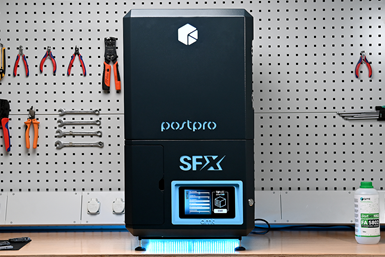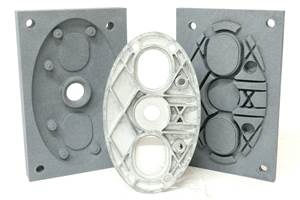PostPro SFX Desktop Vapor Smoothings Enhances Parts’ Visual, Functional Properties
Formnext 2023: This desktop chemical vapor smoothing machine features a compact benchtop design, making it well suited for R&D and low-volume prototyping projects.
Share
Read Next
AMT’s PostPro SFX is a desktop chemical vapor smoothing machine for postprocessing which is designed to work with a variety of 3D printers, including Formlabs’ Fuse 1, Sinterit Lisa, Sintratec and WeMatter platforms, as well as industrial platforms such as Nexa 3SD, 3D Systems, HP, EOS and Stratasys. The machine is compact and versatile, making it well suited for R&D and low-volume prototyping projects, as well as a range of engineering plastics.
This benchtop vapor smoothing system is safe and utilizes the company’s green chemistry, PostPro Pure in quick-change cartridges, for safe, sustainable and hassle-free operation. Compatible with engineering plastics, the system produces a high-quality, vapor-smoothed surface finish even in office environments.
The PostPro SFX is the result of a decade of AMT’s Chemical Vapor Smoothing knowledge and expertise combined with its process, solvents and cartridge systems. It boasts a compact design with a process chamber size of 11 L. It is compatible with all nylons, with future support for flexible materials such as TPEs and TPUs.
Developed with a sustainable future in mind, all the materials are processed exclusively using AMT’s PostPro Pure patent-pending consumable solvent which is delivered by mail to customers in 1-L cartridges that can be safely disposed of by the consumer after use.
The machine is easy to use. Designed to optimize the user experience, and in collaboration with Saint Gobain, the machine ships with the Technology Upgrade Package (TUP LITE) automatic recipe generation software, ensuring that the users get the best results right from the start. The SFX interface is designed for maximum user-friendliness. The operator inputs the thickness of the part, the fill level of the processing chamber, as well as the part characteristics. Following a quick visual inspection, the user is able to input all of the parameters and start the vapor smoothing process.
Vapor smoothing for 3D printing is a process in which additively manufactured parts are exposed to a vapor under carefully controlled conditions. This non-line-of-sight approach creates parts with a smooth surface, improved mechanical performance, sealed and sterilizable surfaces. The vapor smoothing process reduces the surface roughness of the part, enhances the material’s mechanical properties (such as elongation at break and tensile strength) and seals the surface against liquids. The technology smooths and seals the surface and internal cavities of 3D printed polymer parts, while also improving mechanical properties.
The machine features a plug-and-play install architecture. No external facility modifications are required. This enables a simple and fast installation with a small footprint, enabling operation in an office environment.
“We are excited to launch the PostPro SFX and bring the power of chemical vapor smoothing to the desktop,” says Joseph Crabtree, AMT CEO. “We have already seen an extraordinary amount of interest for this machine, and production capacity is quickly being filled. I believe this machine will revolutionize the 3D printing industry and make it easier for users to get the best results from their 3D printed parts.”
The PostPro SFX will start shipping in early 2024. Preorders can be made now through AMT’s website. Orders placed before the end of November 2023 will receive an additional 20%. AMT is also interested to hear from resellers that would like to be considered to resell the new system.
- Learn more about AMT’s PostPro Pure which offers sustainable vapor smoothing chemistry. This FDA-approved chemistry offers a green approach for vapor smoothing 3D printed parts.
- Read about the AMT partnership with Saint-Gobain, to fuel 3D printing postprocessing growth. The companies will apply the Norton application technologies and systems approach to enable the development of a Technology Upgrade Package (TUP) for AMT’s PostPro chemical vapor smoothing (CVS) process
Related Content
When Advocacy Leads to Adoption: How Pella Applies (and Manages) AM Capacity
The window and door maker offers a picture of successful, widespread 3D printing adoption across the different needs of a manufacturing organization. The outreach and education effort worked. Now, here is the next phase.
Read MoreFoundry Lab: How Casting in a Day Will Improve the Design of Metal Parts (Includes Video)
The company’s digital casting process uses 3D printing, but the result is a cast part. By providing a casting faster than a foundry, the company says effective prototyping is now possible for cast parts, as well as bridge production.
Read More3D Printed Tennis Racket Serves a Collaborative Win
The collaboration between All Design Lab and Protolabs led to the creation of a 3D printed tennis racket via direct metal laser sintering, called Hìtëkw. This project not only pushed the limits of additive in terms of design capabilities but revealed how important active communication between customer and manufacturer can be for a project’s success.
Read MoreBike Manufacturer Uses Additive Manufacturing to Create Lighter, More Complex, Customized Parts
Titanium bike frame manufacturer Hanglun Technology mixes precision casting with 3D printing to create bikes that offer increased speed and reduced turbulence during long-distance rides, offering a smoother, faster and more efficient cycling experience.
Read MoreRead Next
Profilometry-Based Indentation Plastometry (PIP) as an Alternative to Standard Tensile Testing
UK-based Plastometrex offers a benchtop testing device utilizing PIP to quickly and easily analyze the yield strength, tensile strength and uniform elongation of samples and even printed parts. The solution is particularly useful for additive manufacturing.
Read MoreBike Manufacturer Uses Additive Manufacturing to Create Lighter, More Complex, Customized Parts
Titanium bike frame manufacturer Hanglun Technology mixes precision casting with 3D printing to create bikes that offer increased speed and reduced turbulence during long-distance rides, offering a smoother, faster and more efficient cycling experience.
Read MoreCrushable Lattices: The Lightweight Structures That Will Protect an Interplanetary Payload
NASA uses laser powder bed fusion plus chemical etching to create the lattice forms engineered to keep Mars rocks safe during a crash landing on Earth.
Read More





















